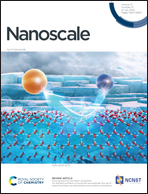Bifacial passivation towards efficient FAPbBr3-based inverted perovskite light-emitting diodes†
Abstract
A unique technique to passivate both bottom and top sides of perovskite has been successfully developed to achieve highly efficient inverted perovskite light-emitting diodes (PeLEDs). For the bottom passivation, an organic/inorganic hybrid electron transporting layer (ETL) replaces the widely adopted inorganic ETL to overcome the disadvantages of the pure inorganic ETL. The ZPM (ZnO-in-polymer matrix) ETL, which consists of ZnO nanoparticles blended into polyvinylpyrrolidone, not only passivates the surface defects of ZnO nanoparticles, but also improves the morphology and stability of FAPbBr3 film. For the top passivation, smaller grains and a FAPbBr3/PEA2PbBr4 3D/2D hybrid structure are obtained by applying a small amount of PEABr solution. The synergetic interplay of organic/inorganic hybrid ETL and organic halide salt surface modification substantially shrinks the grain size to facilitate radiative recombination, and suppresses non-radiative recombination both at the interface of ETL/perovskite and HTL/perovskite, and in the perovskite layer. As a result, the highly efficient green PeLED sets a new record of device performance for FAPbBr3-based inverted PeLEDs, with current efficiency of 39.7 cd A−1, external quantum efficiency of 9.0%, power efficiency of 46.4 lm W−1, maximum luminance of 6.03 × 104 cd m−2, and half-lifetime of 297 minutes at an initial brightness of ∼100 cd m−2.



 Please wait while we load your content...
Please wait while we load your content...